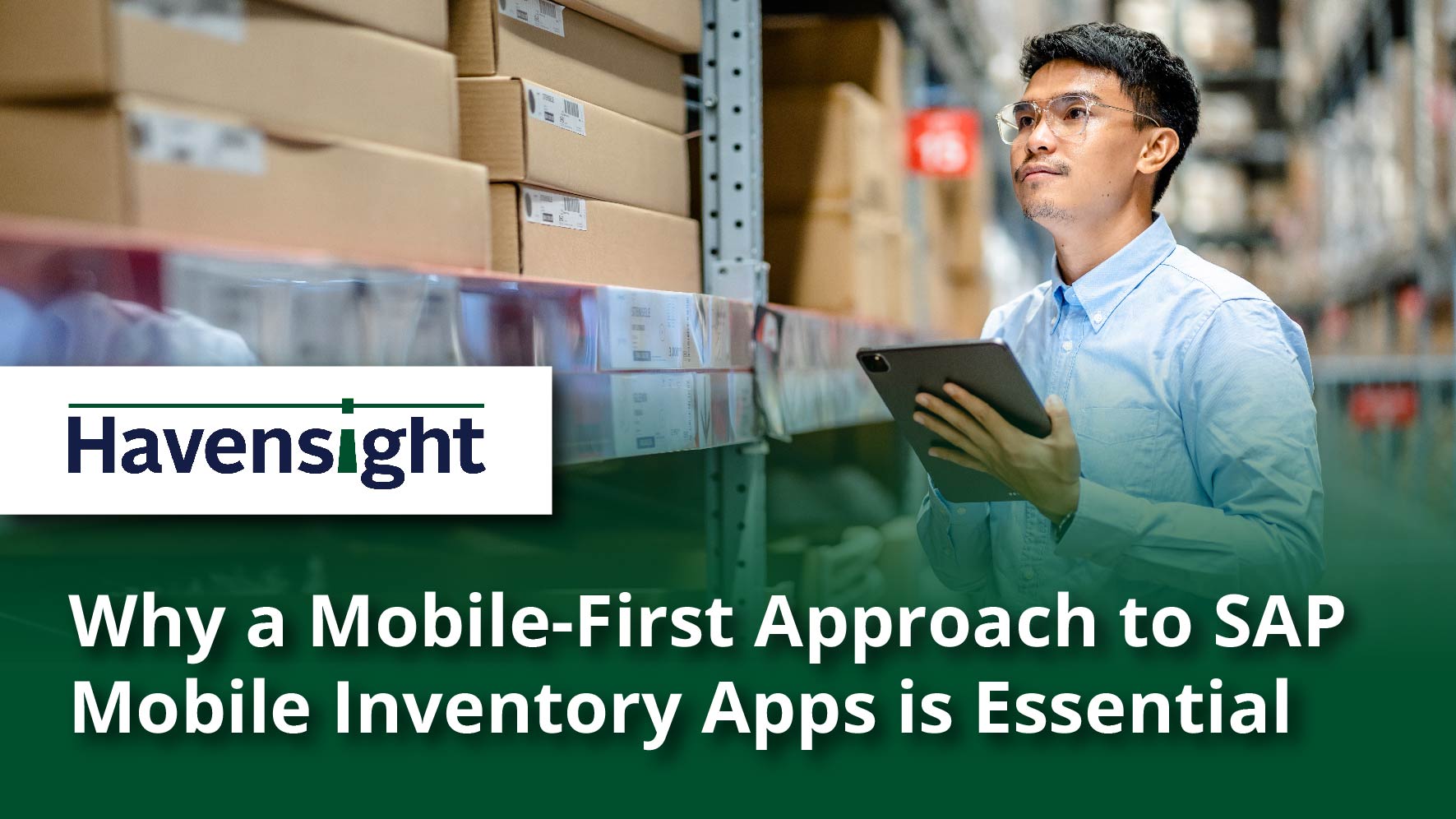6 Key Reasons Not to Use ITS Mobile for Your SAP Inventory Apps
If you’re looking to develop or redevelop an SAP mobile app for warehouse and inventory management, you want your app to be easy to use, to help workers complete tasks as efficiently as possible, and to ensure that your connections and performance are reliable.
To make that happen, you need to make sure that you’re using the right development platform. However, many companies and their development teams make the mistake of using older frameworks and platforms, such as SAP’s ITS Mobile, rather than building apps using the latest native SAP platform, SAPUI5.
In this article, we’ll take a quick look at why you should be using SAPUI5 and not ITS Mobile, what can go wrong if you make the wrong choice, and how our team at Havensight Consulting has successfully developed new SAP mobile apps using SAPUI5 and our Mobile Inventory Templates (MIT).
Why ITS Mobile Is No Longer the Preferred Platform for SAP Mobile Inventory Apps
SAP released ITS Mobile in 2007, to connect mobile devices to SAP. It was designed to replace SAPConsole, the original framework for mobile SAP solutions.
ITS Mobile supports SAP IM, WM and EWM transactions, and, for years, it was the best option for developing SAP mobile apps for warehousing and supply chain management. It was certainly good in its time, but those days are now over, and SAP customers are moving away from it. Here are several very important reasons why:
1. Security Vulnerabilities. ITS Mobile uses client-to-Telnet technology to connect to SAP, and this requires software to connect its Internet Transactions Server to the SAP GUI, which creates serious security vulnerabilities. Since ITS Mobile does not connect directly to SAP and does not use the latest secure authentication methods, it’s simply not safe enough for today’s enterprise security requirements and threats.
2. Poor Connection Handling. A major headache with ITS Mobile is that, if users experience a warehouse network outage or dead zone, all data from the current session is lost. This means the user has to log in and begin the session again, once a connection is re-established, and the interrupted transaction has to be recreated and completed all over again.
This causes costly delays and interruptions, and while some third-party solutions are available to provide limited offline capabilities in such events, there is no option for full offline support.
3. Poor Ease of Use. SAP mobile apps built with ITS Mobile require users to know extensive transaction codes and acronyms in order to correctly choose the right functions and exception codes to execute tasks. It’s a very old-school and cumbersome way to do things, and while it
might offer job security to those who can memorize all those functions and codes, it can be a nightmare for training and onboarding new workers.
4. Complex and Cluttered Screen Layouts. During its time, ITS Mobile represented a significant improvement in user experience, as it allowed us to move away from green-screen-style layouts to browser-based technology that allowed information and workflows to be presented in a modern style with buttons, backgrounds, and better flow.
However, compared to what’s now possible with the latest mobile development platforms and frameworks, ITS Mobile apps are now shockingly clunky, cluttered and often inefficient. Screen layouts are complicated, with every field displayed on screen, even if it’s not needed, and fields aren’t clearly labeled. Any changes to the screen layout require significant development work, and a separate screen set is required for each device form factor.
5. Slow App Response Times. Anyone who’s used old-school industrial mobile apps probably knows this pain, but response times with ITS Mobile have been historically poor. App slowdowns and delays in response times are a frequent occurrence, and in today’s warehouse and supply chain operations, where every second counts and efficiency has never been more important, this can be an absolute killer.
To get around this, ITS Mobile solutions are often paired with third-party tools to help improve performance, but the bottom line is that you’re still working with an outdated programming model, transaction server, and connection technology at the core, so you’re not going to get anything close to the fast and responsive performance that you can get with solutions built on a current platform.
6. Lack of Hardware Support. Another big limitation of ITS Mobile is that it doesn’t support all the device types, form factors, screen sizes, and data capture capabilities that are available today. ITS Mobile was released in 2007, the same year that the original iPhone debuted and long before the advent of today’s tablet computers, RFID readers, and other devices.
As a result, apps built with ITS Mobile don’t render automatically, seamlessly and optimally on different devices, and they lack support for data capture needs as well, such as being limited to wedge scanning only.
A Better Alternative to SAP ITS Mobile
Fortunately, as mobile devices and mobile workflow requirements have evolved, so has SAP’s options for mobile app development. In 2013, SAP introduced SAPUI5, a future-forward native SAP platform that uses HTML5 to enable faster and easier development of mobile SAP apps with all the performance, capabilities, and compatibility that enterprises need.
At Havensight Consulting, where our team has deep experience with all of SAP’s mobile solution platforms, we’ve been using SAPUI5 since our inception, and we’ve used it to successfully develop and redevelop SAP mobile apps for dozens of leading global clients.
We’ve also combined SAPUI5 with an in-house toolset that we call Mobile Inventory Templates (MIT). These pre-built templates provide high-performance, mobile workflows that easily execute inventory transactions with a modern, intuitive user experience as well as a direct and native connection to SAP.
The apps that we build with SAPUI5 and MIT support SAP IM, WM, and EWM transactions, and they create an efficient and elegant user experience that’s intuitive to both new and existing users. They take advantage of the latest mobile development tools to help streamline processes, remove unnecessary functions, buttons, and steps, and to optimize mobile workflows.
They also provide modern SAP authentication with native technology and direct connections for superior security and stability. And they use SAP’s modern HTML5 framework for data integration over the web, so they provide vastly better response times and performance.
Additionally, the apps that we build provide connected, limited offline, or full offline functionality with direct connection to SAP. There are no more lost transactions due to warehouse dead zones, network outages, or poor Wi-Fi coverage.
Importantly, each app is also compatible with all modern devices and peripherals, including integration with scanners and devices with cameras, microphones, Bluetooth and other capabilities. They run on any Windows, Android or iOS device natively, with screens that automatically render and adapt to each device and its screen size, whether it’s a handheld, a tablet, a vehicle-mounted device, a wearable computer, or another mobile technology.
For a quick review of how our SAPUI5 and MIT-built apps compare to ITS Mobile, check out our quick comparison chart. We’ve covered a lot of these points in this article, but it’s a handy reference if you’re evaluating your options and need a quick summary.
However, you can also schedule a free consultation with us, to learn more about the advantages of Havensight MIT vs. ITS Mobile. We can show you how we’ve used our pre-built templates to develop SAP mobile apps for inventory and warehouse management. We can also explore your mobile inventory management needs and recommend the right approach for your business.
To get started, schedule an online meeting with us at your convenience, call us at 612-964-1999, or email us now.


